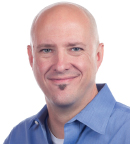
Greg Matthews
In a one-story concrete industrial building across the street from a lumberyard in Austin, Texas, Greg Matthews and his computers are tracking everything that more than 500,000 U.S.-based physicians post publicly on social media. Every tweet. Every public blog, Facebook, or Instagram post. Every YouTube video.
If you’re a U.S. physician and active on social media, Mr. Matthews likely has your public posts on file. Did you comment on a colleague’s paper? Discuss a new drug? Answer a patient’s question? It’s in there.
Furthermore, Mr. Matthews, Managing Director of MDigitalLife, a division of the communications firm W2O Group, and his colleagues are analyzing what you’re saying and aggregating that information to provide insights and analysis to drug companies and other health-care organizations. MDigitalLife claims that 70% of the world’s largest pharmaceutical firms are among its clients.
“People are listening, especially to doctors,” Mr. Matthews said in an interview. “Research has shown that doctors are patients’ number one most trusted source of health information online. So when doctors go online in the form of a blog or a Twitter account, they tend to be taken quite seriously, not only by their peers, but also by patients and advocates.”
Mr. Matthews emphasized that no personal information is collected or shared. “Our first rule is that we don’t do any work that would be harmful to doctors,” he said “We’re here to support online physicians because we believe that the more of them there are, the better it is for the health of the world.”
Annual Report on Oncology Social Media
Three years ago, MDigitalLife began tracking physicians’ digital footprints on public social media channels and matching names with U.S. medical license numbers to verify their identities. The company claims to have “the world’s first and only database to link physicians’ online content to their national physician registry records.”
Once matched, the posts are pulled into a database and the social media analytics begin. “Depending on what our clients need, we can search the data by topics,” Mr. Matthews said. “We will look at hundreds of keywords that doctors could use to talk about cancer, and then we could say, for example, ‘Oncologists in South Florida who graduated from medical school before 1990 talk about stage IV metastatic breast cancer like this, whereas another group talks about it like that.’”
The medical license number enables the database to pull in other public data sources including Medicare referrals and prescribing data, as well as research listed on PubMed.
“We’re able to overlay all kinds of different data to help build a more robust understanding of who these doctors are and who’s influential in changing the way people think about a certain subject, whether it’s in more traditional ways like publishing research or speaking at a medical congress, or a less conventional way like being a blogger or an active Twitter user,” Mr. Matthews said.
In 2013, MDigitalLife published the first of what has become an annual report on social media conversations specifically around cancer. Called “The Social Oncology Project,” the report tracks the rise of broad and interconnected “communities” of oncologists, journalists, advocates, and people with cancer. Most of this interaction takes place over Twitter, although public Facebook pages for doctors, hospitals, professional societies, and advocacy organizations also play an increasing role.
The most recent report found that U.S. physicians tweeted 138,000 times about cancer-related topics in 2014, compared to only 82,000 in 2013. About 5,500 different physicians were involved in those conversations. The report is available as a free download at http://mdigitallife.com/socialoncology.

Brian Reid, MS
“There is a large and engaged physician community on Twitter,” said Brian Reid, MS, of W2O Group, who coauthored the report with Matthews and lead analyst Kayla Rodriguez. “For a long time, there was a debate about whether social media tools would ever have a level of adoption among physicians that was large enough to be meaningful. What we found was that, absolutely, that community has formed.”
The largest such Twitter oncology community in the U.S. centers around breast cancer, the report found. The volume of online dialogue in breast cancer is greater than that in lung, prostate, colon, and pancreatic cancers plus lymphoma combined. Among physicians, breast cancer was mentioned at more than double the rate of lung cancer, the second-most mentioned cancer in 2014.
Twitter users follow specific topics by including descriptive hashtags. One of the most popular in oncology is #BCSM, which stands for Breast Cancer Social Media, a Twitter discussion (known as a “tweetchat”) that alone was responsible for 8,300 physician tweets in 2014, the report said.
The #BCSM tweetchat was begun by two breast cancer survivors, Alicia Staley and Jody Schoger, along with Deanna J. Attai, MD, Assistant Clinical Professor of Surgery at the David Geffen School of Medicine at the University of California, Los Angeles. Dr. Attai’s 3,300 breast cancer tweets made her the most active tweeter on breast cancer in 2014, according to the report. She was also the most-mentioned individual among a sample of physician tweets the project examined, and she had the second-most mentioned Twitter handle among patients.
Opinion Leaders to Watch
Mr. Matthews and Mr. Reid call physicians like Dr. Attai “superusers.” These top 10% of oncologist tweeters generated 77% of the cancer-related tweets in 2014. The superusers have large lists of followers and heavily influence the community’s conversations. According to the report, four of the top five tweeters by volume in 2014 were selected by ASCO as “Featured Voices” for the 2015 Annual Meeting.
“We discovered that about 2 to 8 weeks after these key influencers introduce something new to the online ecosystem, that topic becomes essentially mainstream,” Mr. Matthews said. “A significant group of others begin to adopt that position or that language.”
But being a superuser doesn’t give a physician automatic public celebrity, the report found. The most retweeted physicians discussing cancer tended to be those with an established popular culture profile. In 2014, cancer-related tweets by Jen Arnold, MD, star of the TLC show “The Little Couple,” were retweeted more than 100 times, on average. Writer and surgeon Atul Gawande, MD, MPH, generated an average of nearly 70 retweets for every tweet about cancer.
Mr. Matthews and Mr. Reid contend that despite the popularity of the celebrity physicians, it’s the oncology superusers who are most influential among patients and physicians. Media stars are rarely mentioned by oncologists on Twitter.
“The popular culture doctors are not in any way having an impact on the thought leadership among physicians, no matter how big their footprint is among consumers,” Mr. Reid said.
Social Media Benefits and Risks
Physicians active on Twitter or Facebook, or those considering getting involved, should be aware that their statements can have a large impact.
“If you’re online, you need to be concerned about who’s listening,” Mr. Matthews said. “You need to represent yourself in such a way that you would be okay with being quoted in a newspaper article.”
Mr. Reid said that Twitter groups like #BCSM provide unprecedented opportunities for physicians and patients to learn from each other. “Patients have access to expert commentary and other patients in a way that wasn’t available previously,” he continued. “Doctors didn’t often have the opportunity to hear from patients about how cancer really makes them feel. It’s an interesting exchange that’s really hard to replicate in the real world.”
ASCO offers “Social Media 101” resources for cancer care providers, patients, and advocates on its website at http://asco.org/socialmedia. ■
Disclosure: Mr. Matthews and Mr. Reid reported no potential conflicts of interest.

